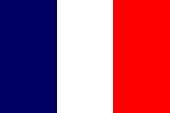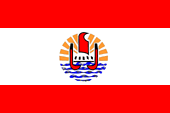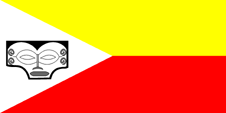Marquesas-Inseln |
|
|
|
| Übersicht – Contents: | |
Marquesas-Inseln |
|
|
|
| Übersicht – Contents: | |
Flaggen – Flags: |
|
 |
die Flagge
Frankreichs |
 |
seit /since 1984,    |
|
|
|
inoffizielle Flagge – unofficial Flag: |
|
 |
seit/since 1984, |
|
|
|
| Die Marquesas-Inseln – als Teil von Französisch-Polynesien – haben offiziell keine eigene Flagge. Es muss die französische Trikolore oder zusätzlich die Flagge von Französisch-Polynesien gehisst werden. Jedoch gibt es for lokale Zwecke eine inoffzielle Flagge. Diese wurde im Jahre 1984 durch Bischof Herve-Marie Le Cleac'h geschaffen. Die Flagge zeigt zwei waagerechte Streifen in Gelb und Rot und ein gleichschenkliges weißes Dreieck am Liek. In der Mitte des Dreiecks der "Kopf des Tiki". Weiß steht für Frieden, Rot steht für die Federn des heiligen Vogels Kua. Gelb ist ein wichtiger einheimischer Farbstoff. |
The Marquesas Islands – as a part of French Polynesia
– have officially no own flag. It must be hoisted the French tricolor or
additionally, the flag of French Polynesia. However, there exists for local
purposes an unofficial flag. This flag is unofficial and was created by Bishop Herve-Marie Le Cleac'h in the year 1984. The flag shows two horizontal stripes in yellow and red and an isosceles white triangle at the leech. In the middle of the triangle the "Head of Tiki". White stands for peace, red stands for the feathers of the holy bird Kua. Yellow is an important local dye. |
| Quelle/Source: Wikipedia (D), FOTW | |
|
|
|
| Landkarten – Maps: |
Lage – Position: |
Landkarte von Französisch-Polynesien – Map of French Polynesia: |
Landkarte der Inseln – Map of the Islands: |
Gliederungen von Französisch-Polynesien – Subdivisions of French Polynesia: |
| Zahlen und Fakten – Numbers and Facts: | |
|
|
|
|
|
|
|
|
|
|
|
|
|
|
|
|
| Quelle/Source: Wikipedia (EN) | |
|
|
|
|
ca. 500 v.Chr. · beginnende polynesische Besiedlung 1595 · der spanische Seefahrer Alvaro de Mendaña de Neyra entdeckt die Inselgruppe und nennt sie nach Marques de Mendoza, dem Vizekönig von Peru 1774 · der britische Seefahrer James Cook durchreist die Inselgruppe 1791 · der US-amerikanische Seefahrer Joseph Ingraham entdeckt die Nordwestgruppe der Marquesas 1792 · der britische Leutnant Richard Hergest von der SMS Daedalus kartiert die Marquesas-Inseln 1804 · der russische Seefahrer Adam Johann von Krusenstern durchreist die Inselgruppe und weilt auf Nuku Hiva 1813 · der US-amerikanische Kommodore David Porter ankert mit der Fregatte USS Essex vor Nuku Hiva, nimmt die Insel am 19. November für die USA in Besitz, und nennt sie „Madison Island“, der US-Kongress ratifiziert die Inbesitznahme jedoch nicht 1838 · der Franzose Abel Aubert Dupetit-Thouars landet mit katholischen Missionaren auf den Inseln 1838· der französische Seefahrer Jules Dumont d’Urville durchreist die Inselgruppe 1842 · Frankreich erklärt die Marquesas-Inseln zum französischen Protektorat 1863 · schwere Pockenepidemie 1903 · Errichtung einer einheitlichen französischen Kolonialverwaltung für die Gesellschaftsinseln, Marquesas-Inseln, Tuamotuinseln, Gambier-Inseln und Austral-Inseln unter dem Namen "Französisch-Polynesien" |
|
|
|
ca. 500 B.C. · beginning polynesian settlement 1595 · the Spanish seafarer Álvaro de Mendaña de Neira discoveres the archipelago and names it after Marques de Mendoza, the viceroy of Peru 1774 · the British seafarer James Cook travels through the archipelago 1791 · the US-american seafarer Joseph Ingraham discovers the northwestern group of the Marquesas 1792 · the British Lieutenant Richard Hergest of the SMS Daedalus mappes the Marquesas Islands 1804 · The Russian seafarer Adam Johann von Krusenstern travels through the archipelago and spends a few days on Nuku Hiva 1813 · the US-american Commodore David Porter anchors with the frigate USS Essex before Nuku Hiva, and takes the island for the United States in possession on 19th of November, and names it "Madison Iceland", but the US Congress did not ratify the seizure 1838 · the Frenchman Abel Aubert Dupetit-Thouars lands with Catholic missionaries on the islands 1838 · the French navigator Jules Dumont d'Urville travels through the archipelago 1842 · France declares the Marquesas Islands to a French Protectorate 1863 · severe pox epidemic 1903 · establishing of a unified French colonial administration for the Society Islands, Marquesas Islands, Tuamotu Islands, Gambier Islands and Austral Islands under the name "French Polynesia" |
| Quelle/Source Wikipedia (D), FOTW |
|
|
| Als der Spanier Alvaro de Mendaña de Neyra
im Jahre 1595 die Inselgruppe – auf einer Fahrt von Peru zu den Salomonen –
entdeckte, benannte er sie nach Marques de Mendoza, dem Vizekönig von Peru: "Las Islas Marquesas Don García Hurtado de Mendoza y Canete",
voraus verkürzt die "Marquesas-Inseln" wurden. Im 18./19. Jahrhundert nannte
man sie jedoch auch noch nach ihrem Entdecker: Mendaña-Inseln |
As the Spaniard
Alvaro de Mendaña de Neyra in 1595 discovered the archipelago during a trip from Peru to
the Solomon Islands, he named the islands after Marques de Mendoza, the viceroy of Peru: "Las Islas Marquesas Don García Hurtado de Mendoza y Canete",
from what arised the short version "Marquesas Islands". However, in the 18th/19th
century the archipelago was also called after its discoverer: Mendaña Islands
| Quelle/Source:
Wikipedia
(D) |
|
| ||